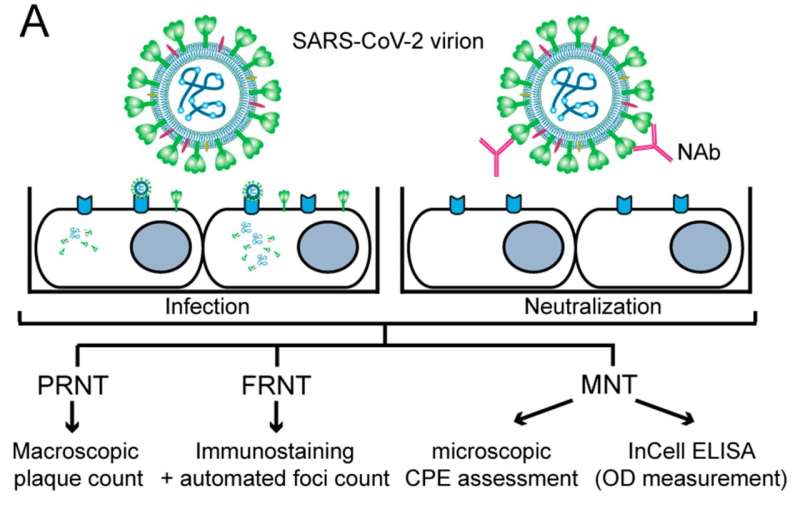Principle of cell-culture-based neutralization assays. (A) Conventional virus-neutralization test (VNT) and (B) pseudovirus-neutralization test (pVNT) are laboratory methods primarily used for identifying whether neutralizing antibodies (NAbs) against SARS-CoV-2 are present in the patient sample. Both tests involve incubating patient serum with the virus (A) or pseudovirus (B), and then inoculating onto cell culture. If NAbs are present and the virus is neutralized, the cells will not be infected. Accordingly, there will be a reduction in plaque formation or expression of virus proteins in the plaque-reduction neutralization assay (PRNT) and focus-reduction neutralization assay (FRNT), respectively. If NAbs are not present, the virus will infect the cells. In pVNT, a recombinant or chimeric virus with SARS-CoV-2 S protein on its surface bearing a reporter gene is used for increased safety and easier readout. A reduction in the reporter gene expression reflects the presence of NAbs. Credit: International Journal of Molecular Sciences (2023). DOI: 10.3390/ijms24065352
Mutations of virus and illnesses caused by new variants are still to be expected even in a SARS-CoV-2 situation that has now become endemic. Although the population has developed specific immune responses due to previous infections and vaccinations, vaccinated and vulnerable individuals continue to contract COVID-19.
In a review of the current state of knowledge, a research team led by Rudolf Valenta from MedUni Vienna concluded that only a survey of neutralizing antibodies can inform us about protection against new infections. In another study, the team analyzed specific characteristics of these neutralizing antibodies and discovered a previously unknown weak point of the virus. Both studies were published in the International Journal of Molecular Sciences.
Three years after the start of the SARS-CoV-2 pandemic, there are still many unresolved questions and challenges, also regarding future virus mutations. Previous studies had already shown that the quantity of antibodies alone is not meaningful for assessing protection against new infections.
A recently published review article on findings from the pandemic by Rudolf Valenta and Pia Gattinger from the Centre for Pathophysiology, Infectiology and Immunology at MedUni Vienna made it clear once again that, contrary to a widely held view, it is not merely the presence of antibodies that is decisive for the protection against new infections, but the fact as to whether they are sufficiently neutralizing antibodies, because only these prevent the virus from docking to the human cells.
Non-neutralizing antibodies cannot prevent docking with human cells. In typical antibody measurements, however, the properties of the antibodies are usually not differentiated.
Determining the time for booster immunization
To determine the neutralizing antibodies, a special serological test is necessary. Due to the infectious nature of the virus, classic virus neutralization tests can only be carried out in a few highly specialized laboratories under strict safety conditions. At MedUni Vienna's Centre for Pathophysiology, Infectiology and Immunology, a simple procedure was therefore developed as early as 2020, by means of which protection against new infections from various virus variants can be examined quickly and in large numbers of samples.
The analysis of neutralizing antibodies could provide valuable information for determining the timing and selection of adapted vaccines for booster vaccinations.
'Achilles heel' of virus detected
In a further study, the team was able to identify a previously unknown Achilles' heel of the virus by determining neutralizing antibodies in vaccinated individuals. It was observed that the defense against the virus is related to the binding of neutralizing antibodies against a previously unknown epitope, i.e. a specific region on the surface of the virus.
What is remarkable for the researchers is that this is a site of the virus that has not changed in the different virus variants, i.e. it is a conserved site. This finding is relevant for the production of improved vaccines in order to specifically use such epitopes for production.
More information: Pia Gattinger et al, Importance, Applications and Features of Assays Measuring SARS-CoV-2 Neutralizing Antibodies, International Journal of Molecular Sciences (2023). DOI: 10.3390/ijms24065352
Maria Byazrova et al, Dissection of Antibody Responses of Gam-COVID-Vac-Vaccinated Subjects Suggests Involvement of Epitopes Outside RBD in SARS-CoV-2 Neutralization, International Journal of Molecular Sciences (2023). DOI: 10.3390/ijms24065104
Provided by Medical University of Vienna
























